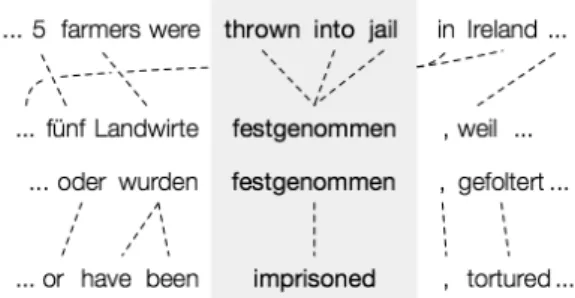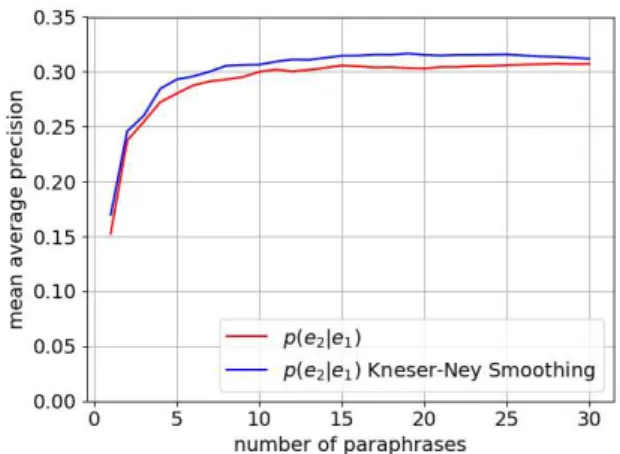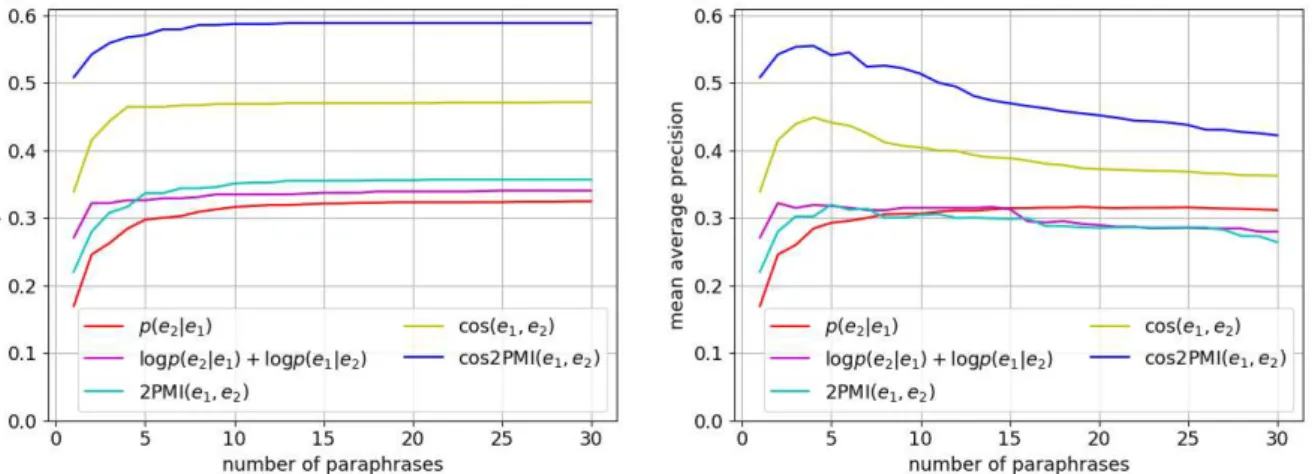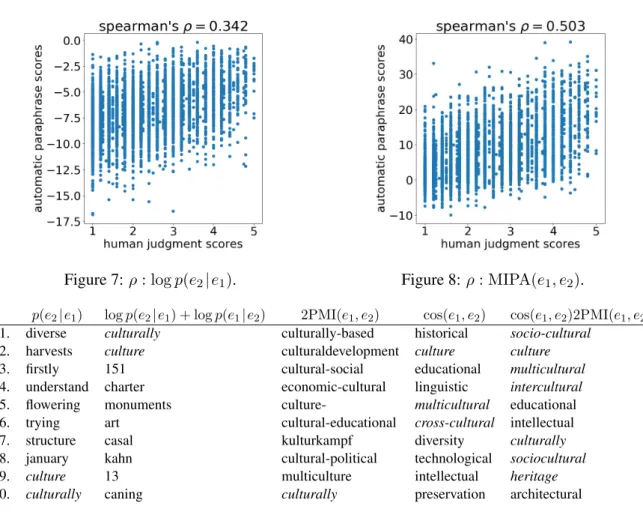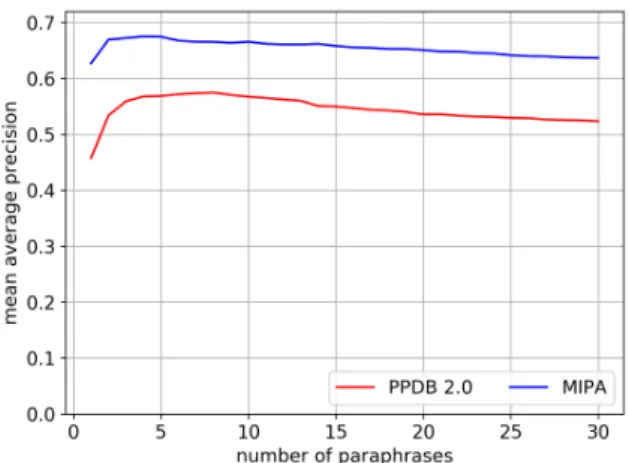MIPA: Mutual Information Based
Paraphrase Acquisition via Bilingual Pivoting
Tomoyuki Kajiwara∗ Mamoru Komachi† Daichi Mochihashi‡
∗Tokyo Metropolitan University, Tokyo, Japan,kajiwara-tomoyuki@ed.tmu.ac.jp †Tokyo Metropolitan University, Tokyo, Japan,komachi@tmu.ac.jp
‡The Institute of Statistical Mathematics, Tokyo, Japan,daichi@ism.ac.jp
Abstract
We present a pointwise mutual informa-tion (PMI) based approach for formaliz-ing paraphrasability and propose a variant of PMI, called mutual information based paraphrase acquisition (MIPA), for para-phrase acquisition. Our parapara-phrase acqui-sition method first acquires lexical para-phrase pairs by bilingual pivoting and then reranks them by PMI and distributional similarity. The complementary nature of information from bilingual corpora and from monolingual corpora renders the pro-posed method robust. Experimental re-sults show that the proposed method sub-stantially outperforms bilingual pivoting and distributional similarity themselves in terms of metrics such as mean reciprocal rank, mean average precision, coverage, and Spearman’s correlation.
1 Introduction
Paraphrases are useful for flexible language understanding in many NLP applications. For example, the usefulness of the paraphrase database PPDB (Ganitkevitch et al., 2013; Pavlick et al., 2015), a publicly available large-scale resource for lexical paraphrasing, has been reported for tasks such as learning word embeddings (Yu and Dredze, 2014) and semantic textual similarity (Sultan et al., 2015). In PPDB, paraphrase pairs are acquired via word alignment on a bilingual corpus by a process called bilingual pivoting (Bannard and Callison-Burch, 2005). Figure 1 shows an example of English language paraphrase acquisition using the German language as a pivot.
Although bilingual pivoting is widely used for paraphrase acquisition, it always includes noise
Figure 1: Paraphrase acquisition via bilingual piv-oting (Ganitkevitch et al.,2013).
due to unrelated word pairs caused by word align-ment errors on the bilingual corpus. Distribu-tional similarity, another well-known method for paraphrase acquisition, is free of alignment er-rors, but includes noise due to antonym pairs that share the same contexts on the monolingual cor-pus (Mohammad et al.,2013).
In this study, we formalize the paraphrasability of paraphrase pairs acquired via bilingual pivoting using pointwise mutual information (PMI) and re-duce the noise by reranking the pairs using dis-tributional similarity. The proposed method ex-tends Local PMI (Evert, 2005), which is a vari-ant of weighted PMI that aims to avoid low-frequency bias in PMI, for paraphrase acquisi-tion. Since bilingual pivoting and distributional similarity have different advantages and disad-vantages, we combine them to construct a com-plementary paraphrase acquisition method, called mutual information based paraphrase acquisition (MIPA). Experimental results show that MIPA outperforms bilingual pivoting and distributional similarity themselves in terms of metrics such as mean reciprocal rank (MRR), mean average pre-cision (MAP), coverage, and Spearman’s correla-tion.
The contributions of our study are as follows.
• Bilingual pivoting-based lexical paraphrase acquisition is generalized using PMI.
• Lexical paraphrases are acquired robustly us-ing both bilus-ingual and monolus-ingual corpora.
• We release our lexical paraphrase pairs1.
2 Bilingual Pivoting
Bilingual pivoting (Bannard and Callison-Burch, 2005) is a method used to acquire large-scale lex-ical paraphrases by two-level word alignment on a bilingual corpus. Bilingual pivoting employs a conditional paraphrase probability p(e2|e1) as a paraphrasability measure, when word alignments exist between an English phrasee1 and a foreign language phrasef, and between the foreign lan-guage phrasefand another English phrasee2on a bilingual corpus. It calculates the probability from an English phrasee1 to another English phrasee2
using word alignment probabilities p(f|e1) and
p(e2|f); here, the foreign language phrase f is used as the pivot.
p(e2|e1) = ∑
f p(e2|f, e1)p(f|e1) ≈∑f p(e2|f)p(f|e1)
(1)
It assumes conditional independence ofe1ande2
given f, so that the equation above can be es-timated easily using phrase-based statistical ma-chine translation models. One of its advantages is that it requires only two translation models to ac-quire paraphrases on a large scale. However, since the conditional probability is asymmetric, it may introduce irrelevant paraphrases that do not hold the same meaning as the original one. In addi-tion, owing to the data sparseness problem in the bilingual corpus, paraphrase probabilities may be overestimated for low-frequency word pairs.
To mitigate this, PPDB (Ganitkevitch et al., 2013) defined the symmetric paraphrase score
sbp(e1, e2)using bi-directional bilingual pivoting.
sbp(e1, e2) =−λ1logp(e2|e1)−λ2logp(e1|e2) (2) Unlike Equation (1),sbpenforces mutual
para-phrasability of e1 and e2. As discussed later, this does not necessarily increase the performance of paraphrase acquisition, because the symmetric constraint may be too strict to allow the extrac-tion of broad-coverage paraphrases. In this study,
1https://github.com/tmu-nlp/pmi-ppdb
without loss of generality, we set2λ1 =λ2 =−1.
sbp(e1, e2) = logp(e2|e1) + logp(e1|e2) (3)
Although these paraphrase acquisition methods can extract large-scale paraphrase knowledge, the results may contain many fragments caused by word alignment error.
3 MIPA: Mutual Information Based Paraphrase Acquisition
To mitigate overestimation, we acquire lex-ical paraphrases with the conditional para-phrase probability by using Kneser-Ney smooth-ing (Kneser and Ney, 1995) and reranking them using information theoretic measure from a bilin-gual corpus and distributional similarity calculated from a large-scale monolingual corpus.
3.1 Smoothing of Bilingual Pivoting
Since bilingual pivoting adopts the conditional probability p(e2|e1) as paraphrasability, we can mitigate the problem of overestimation by apply-ing a smoothapply-ing method.
In the hierarchical Bayesian model, the condi-tional probability p(y|x) is expressed using the Dirichlet distribution with parameterαy and
max-imum likelihood estimationpˆy|xas follows. p(y|x) = ∑n(y|x) +αy
y(n(y|x) +αy)
≃ n(y|x)
n(x) +∑
yαy
∵αy ≪1
= n(x)
n(x) +∑
yαy
·n(y|x)
n(x)
= n(x)
n(x) +∑
yαy
·pˆy|x
(4)
Here, n(x) indicates the frequency of a word x
andn(y|x)indicates the co-occurrence frequency of wordy followingx. As∑
yαy is too large to
be ignored, especially when the frequencyn(x)is small, Equation (4) shows that the maximum like-lihood estimationpˆy|xestimates the probability to be excessively large.
Therefore, we propose using Kneser-Ney smoothing (Kneser and Ney,1995), which is con-sidered to be an extension of the Dirichlet smooth-ing above, to mitigate overestimation of para-phrase probability in bilingual pivoting.
2
PPDB3:λ1=λ2= 1
pKN(e2|e1) = n(e2|e1)−δ
n(e1) +γ(e1)pKN(e2)
δ = N1
N1+ 2N2
γ(e1) =
δ
n(e1)N(e1) (5)
pKN(e2) = ∑N(e2)
iN(ei)
Here, Nn indicates the number of types of word
pairs of frequencynandN(e1)indicates the num-ber of types of paraphrase candidates of worde1.
3.2 Generalization of Bilingual Pivoting using Mutual Information
The bi-directional bilingual pivoting of PPDB (Ganitkevitch et al., 2013) constrains paraphrase acquisition to be strictly symmetric. However, although it is extremely effective for extracting synonymous expressions, it tends to give high scores to frequent but irrelevant phrases, since bilingual pivoting itself contains noisy phrase pairs because of word alignment errors.
To address the problem of frequent phrases, we smooth paraphrasability by bilingual pivoting in Equation (3) using word probabilities p(e1) and
p(e2) from a monolingual corpus that is suffi-ciently larger than the bilingual corpus.
spmi(e1, e2) = logp(e2|e1) + logp(e1|e2) −logp(e1)−logp(e2) (6)
Thus, we can interpret the bi-directional bilingual pivoting as an unsmoothed version of PMI. Since the difference in the logarithms of the numerator and denominator is equal to the logarithm of the quotient, we can transform Equation (6) as
spmi(e1, e2) = log
p(e2|e1)
p(e2) + log
p(e1|e2)
p(e1) = 2PMI(e1, e2) (7)
since we can transform PMI into the following forms using Bayes’ theorem.
PMI(x, y) = log p(x, y)
p(x)p(y) (8)
= log p(y|x)p(x)
p(x)p(y) = log
p(y|x)
p(y)
= log p(x|y)p(y)
p(x)p(y) = log
p(x|y)
p(x)
Plugging Equation (8) into Equation (7), we can interpret PMI as a geometric mean of two models.
PMI(x, y) = 1
2PMI(x, y) + 1
2PMI(x, y) (9)
= 1 2log
p(y|x)
p(y) + 1 2log
p(x|y)
p(x)
= log
[ {
p(y|x)
p(y)
}1 2 ·
{
p(x|y)
p(x)
}1 2
]
Bilingual pivoting in Equation (1) can be re-garded as a mixture model that considers only the
e1 → e2 direction. However, as shown in Equa-tion (9), our proposed method can be regarded as a product model (Hinton,2002) that considers both directions. PPDB (Pavlick et al.,2015) also considers the paraphrase probability in both direc-tions, but the authors did not regard it as a product model; instead the paraphrase probability in each direction is treated as one of the features of super-vised learning.
3.3 Incorporating Distributional Similarity
In low-frequency word pairs, it is well-known that PMI becomes unreasonably large because of co-incidental co-occurrence. In order to avoid this problem,Evert(2005) proposed Local PMI, which assigns weights to PMI depending on the co-occurrence frequency of word pairs.
LocalPMI(x, y) =n(x, y)·PMI(x, y) (10)
In this study, however, it was difficult to directly calculate the weight corresponding to n(x, y) in Equation (10) on the bilingual corpus. Further-more, our aim was to calculate not the strength of co-occurrence (relation) between words, but the paraphrasability. Therefore, it is not appropriate to count the co-occurrence frequency on a monolin-gual corpus such as Local PMI.
Alternatively, we use as a weight the distri-butional similarity, which is frequently used for paraphrase acquisition from a monolingual cor-pus (Chan et al.,2011;Glavaˇs and ˇStajner,2015).
slpmi(e1, e2) =cos(e1, e2)·spmi(e1, e2)
=cos(e1, e2)·2PMI(e1, e2) (11)
Here, cos(e1, e2) indicates cosine similarity be-tween vector representations of worde1and word
Figure 2: Effectiveness of smoothing of bilingual pivoting evaluated by paraphrase ranking in MRR.
Figure 3: Effectiveness of smoothing of bilingual pivoting evaluated by paraphrase ranking in MAP.
(bilingual pivoting). Distributional similarity, as opposed to bilingual pivoting, is robust against noise associated with unrelated word pairs. Bilin-gual pivoting is robust against noise arising from antonym pairs, unlike distributional similarity. Therefore, slpmi(e1, e2) can perform paraphrase acquisition robustly by compensating the disad-vantages. Hereinafter, we refer to slpmi(e1, e2) as MIPA, mutual information based paraphrase ac-quisition via bilingual pivoting.
4 Experiments
4.1 Settings
We used French-English parallel data4 from Europarl-v7 (Koehn, 2005) and GIZA++ (Och and Ney, 2003) (IBM model 4) to calculate the conditional paraphrase probability
p(e2|e1)andp(e1|e2). We also used the English Gigaword 5th Edition5 and KenLM (Heafield,
2011) to calculate the word probability p(e1)
and p(e2). For cos(e1, e2), we used the CBOW model6 of word2vec (Mikolov et al., 2013a).
Finally, we acquired paraphrase candidates of 170,682,871 word pairs, excepting the paraphrase of itself (e1=e2).
We employed the conditional paraphrase prob-ability of bilingual pivoting given in Equation (1), the symmetric paraphrase score of PPDB given by Equation (3), and distributional similarity as baselines, and compared them with PMI shown in Equation (7) and the MIPA score given in Equa-tion (11). Note that distributional similarity
im-4
http://www.statmt.org/europarl/ 5
https://catalog.ldc.upenn.edu/LDC2011T07 6https://code.google.com/archive/p/word2vec/
plies that the paraphrase pairs acquired via bilin-gual pivoting were reranked by distributional sim-ilarity rather than by using the top-k distribution-ally similar words among all the vocabularies.
4.2 Evaluation Datasets and Metrics
For evaluation, we used two datasets included in Human Paraphrase Judgments7 published by Pavlick et al. (2015); hereafter, we call these datasets HPJ-Wikipedia and HPJ-PPDB, respec-tively.
First, Human Paraphrase Judgments includes a paraphrase list of 100 words or phrases randomly extracted from Wikipedia and processed using a five-step manual evaluation for each paraphrase pair (HPJ-Wikipedia). A correct paraphrase is a word that gained three or more evaluations in man-ual evaluation. We used this dataset to evaluate the acquired paraphrase pairs by MRR and MAP, following Pavlick et al. (2015). Furthermore, we evaluated the coverage of the top-k paraphrase pairs. Function words such as “as” have more than 50,000 types of paraphrase candidates, be-cause they are sensitive to word alignment errors in bilingual pivoting. However, since many of these paraphrase candidates are word pairs that are not in fact paraphrases, we evaluated the coverage in terms of the extent to which they can reduce un-necessary candidates while preserving the correct paraphrases.
Second, Human Paraphrase Judgments also includes a five-step manual evalu-ation of 26,456 word pairs sampled from PPDB (Ganitkevitch et al., 2013) (HPJ-PPDB)
Figure 4: Paraphrase ranking in MRR. Figure 5: Paraphrase ranking in MAP.
Figure 6: Coverage of the top-k paraphrase pairs.
together with the paraphrase list of 100 words. We used this dataset to evaluate the overall para-phrase ranking based on Spearman’s correlation coefficient, as inPavlick et al.(2015).
4.3 Results
Figures2and3show the effectiveness of adopting Kneser-Ney smoothing for bilingual pivoting in terms of MRR and MAP on HPJ-Wikipedia. The horizontal axis of each graph represents the evalu-ation of the paraphrase up to the top-k of the para-phrase score. The results confirm that the ranking of paraphrases acquired via bilingual pivoting was improved by applying Kneser-Ney smoothing. In the rest of this study, we always applied Kneser-Ney smoothing to conditional paraphrase proba-bility.
Figures 4 and5 show the comparison of para-phrase rankings in MRR and MAP on HPJ-Wikipedia. The evaluation by MRR, shown in
Figure 4, demonstrates that the ranking perfor-mance of paraphrase pairs is improved by making bilingual pivoting symmetric. PMI slightly out-performs the baselines of bilingual pivoting below the top five. Furthermore, MIPA shows the highest performance, because reranking by distributional similarity greatly improves bilingual pivoting.
The evaluation using MAP, shown in Figure5, also reinforced the same result, i.e., reranking by distribution similarity improved bilingual pivot-ing, and MIPA showed the highest performance.
Figure 7:ρ: logp(e2|e1). Figure 8:ρ: MIPA(e1, e2).
p(e2|e1) logp(e2|e1) + logp(e1|e2) 2PMI(e1, e2) cos(e1, e2) cos(e1, e2)2PMI(e1, e2)
1. diverse culturally culturally-based historical socio-cultural
2. harvests culture culturaldevelopment culture culture
3. firstly 151 cultural-social educational multicultural
4. understand charter economic-cultural linguistic intercultural
5. flowering monuments culture- multicultural educational
6. trying art cultural-educational cross-cultural intellectual
7. structure casal kulturkampf diversity culturally
8. january kahn cultural-political technological sociocultural
9. culture 13 multiculture intellectual heritage
10. culturally caning culturally preservation architectural
Table 1: Paraphrase examples ofcultural. Italicized words are the correct paraphrases.
Figures 7 and 8 show the scatter plots and Spearman’s correlation coefficient of each para-phrase score and manual evaluation (average value of five evaluators) on HPJ-PPDB. As in the pre-vious experimental results, MIPA showed a high correlation. In particular, the noise generated by false positives at the upper left of the scatter plot can be reduced by combining PMI and distribu-tional similarity.
5 Discussion
5.1 Qualitative Analysis
Table 1 shows examples of the top 10 in para-phrase rankings. In the parapara-phrase examples of
cultural, conditional paraphrase probability does not score the correct paraphrase as top-ranked words. Although the symmetric paraphrase score ranked the correct paraphrase at the top, words other than the top words are less reliable, as shown by the previous experimental results. PMI is strongly influenced by low-frequency words, and many of the top-ranked words are singleton words in the bilingual corpus. MIPA, in contrast,
mitigates the problem of low-frequency bias, and many of the top-ranked words are correct para-phrases. Distributional similarity-based methods include relatively numerous correct paraphrases at the top, and the other top-ranked words are also strongly related tocultural. From the viewpoint of paraphrases, 3 of the top 10 words of the proposed method are incorrect, but these words may also be useful for applications such as learning word em-beddings (Yu and Dredze,2014) and semantic tex-tual similarity (Sultan et al.,2015).
Table 2 shows correct examples of the para-phrase rankings. In the parapara-phrase examples of
p(e2|e1) logp(e2|e1) + logp(e1|e2) 2PMI(e1, e2) cos(e1, e2) cos(e1, e2)2PMI(e1, e2)
1. workers 9. gardeners 10. workmen 2. workers 2. workers
2. employees 42. harvesters 11. wage-earners 8. people 4. workmen
9. farmers 62. workers 16. earners 10. persons 5. craftsmen
13. labour 71. seafarers 19. workers 11. farmers 6. wage-earners 16. gardeners 73. unions 21. craftsmen 15. craftsmen 9. persons 17. people 99. homeworkers 22. workforces 26. wage-earners 12. employees
28. workmen 283. works 26. employed 27. workmen 13. earners
30. employed 394. workmen 27. employees 29. harvesters 15. farmers 33. craftsmen 395. employees 50. labour 31. seafarers 18. people 59. harvesters 412. wage-earners 55. persons 32. employees 19. workforces 80. work 415. craftsmen 75. farmers 42. gardeners 37. harvesters 88. earners 417. earners 103. homeworkers 47. earners 42. individuals 90. wage-earners 419. labour 105. individuals 55. workforces 53. labour 106. persons 420. employed 112. work 57. individuals 55. seafarers 109. individuals 431. people 135. people 79. unions 65. gardeners 114. seafarers 433. farmers 187. harvesters 103. labour 88. employed 115. unions 446. workforces 273. gardeners 140. homeworkers 100. homeworkers 131. workforces 451. work 317. seafarers 144. work 105. work 166. homeworkers 453. persons 456. unions 170. employed 149. unions
401. works 474. individuals 469. works 222. works 254. works
Table 2: Correct paraphrase examples oflabourers.
p(e2|e1) logp(e2|e1) + logp(e1|e2) 2PMI(e1, e2) cos(e1, e2) cos(e1, e2)2PMI(e1, e2) STS-2012 0.539 0.466 0.383 0.363 0.442
STS-2013 0.489 0.469 0.463 0.483 0.499 STS-2014 0.464 0.460 0.471 0.453 0.475 STS-2015 0.611 0.655 0.660 0.642 0.671 STS-2016 0.444 0.518 0.550 0.518 0.542 ALL 0.536 0.543 0.534 0.523 0.555
Table 3: Evaluation by Pearson’s correlation coefficient in semantic textual similarity task.
5.2 Quantitative Analysis
Next, we applied the acquired paraphrase pairs to the semantic textual similarity task and eval-uated the extent to which the acquired para-phrases improve downstream applications. The semantic textual similarity task deals with calcu-lating the semantic similarity between two sen-tences. In this study, we conducted the eval-uation by applying Pearson’s correlation coeffi-cient with a five-step manual evaluation using five datasets constructed by SemEval (Agirre et al., 2012, 2013, 2014, 2015, 2016). We applied the acquired paraphrase pairs to the unsuper-vised method of DLC@CU (Sultan et al., 2015), which achieved excellent results using PPDB in the semantic textual similarity task of SemEval-2015 (Agirre et al., 2015). DLS@CU performs word alignment (Sultan et al.,2014) using PPDB, and calculates sentence similarity according to the ratio of aligned words:
sts(s1, s2) = na(s1) +na(s2)
n(s1) +n(s2) (12)
Here, n(s) indicates the number of words in sentence s and na(s) indicates the number of
aligned words. Although DLS@CU targets all the paraphrases of PPDB, we used only the top 10 words of the paraphrase score for each target word and compared the performance of the paraphrase scores.
Table 3 shows the experimental results of the semantic textual similarity task. “ALL” is the weighted mean value of the Pearson’s correlation coefficient over the five datasets. MIPA achieved the highest performance on three out of the five datasets. In other words, the proposed method ex-tracted paraphrase pairs useful for calculating sen-tence similarity at the top-rank.
5.3 Reranking PPDB 2.0
Finally, we reranked paraphrase pairs from a publicly available state-of-the-art paraphrase database.8 PPDB 2.0 (Pavlick et al.,2015) scores paraphrase pairs using supervised learning with
Figure 9: Reranking PPDB 2.0 in MRR. Figure 10: Reranking PPDB 2.0 in MAP.
26,455 labeled data and 209 features. We sorted the paraphrase pairs from PPDB 2.0 using the MIPA instead of the PPDB 2.0 score and used the same evaluation means as described in Sec-tion 4. Surprisingly, our unsupervised approach outperformed the paraphrase ranking performance of PPDB 2.0’s supervised approach in terms of MRR (Figure9) and MAP (Figure10).
6 Related Work
Levy and Goldberg (2014) explained a well-known representation learning method for word embeddings, the skip-gram with negative-sampling (SGNS) (Mikolov et al., 2013a,b), as a matrix factorization of a word-context co-occurrence matrix with shifted positive PMI. In this paper, we explained a well-known method for paraphrase acquisition, bilingual pivoting (Bannard and Callison-Burch, 2005; Ganitkevitch et al.,2013), as a (weighted) PMI.
Chan et al.(2011) reranked paraphrase pairs ac-quired via bilingual pivoting using distributional similarity. The main idea of reranking paraphrase pairs using information from a monolingual cor-pus is similar to ours, but Chan et al.’s method failed to acquire semantically similar paraphrases. We succeeded in acquiring semantically similar paraphrases because we effectively combined in-formation from a bilingual corpus and a monolin-gual corpus by using weighted PMI.
In addition to English, paraphrase databases are constructed in many languages using bilingual pivoting (Bannard and Callison-Burch, 2005). Ganitkevitch and Callison-Burch (2014) con-structed paraphrase databases8 in 23 languages, including European languages and Chinese.
Furthermore, Mizukami et al. (2014) constructed the Japanese version9. In this study, we improved bilingual pivoting using a monolingual corpus. Since large-scale monolingual corpora are easily available for many languages, our proposed method may improve paraphrase databases in each of these languages.
PPDB (Ganitkevitch et al., 2013) constructed by bilingual pivoting is used in many NLP applications, such as learning word embed-dings (Yu and Dredze, 2014), semantic textual similarity (Sultan et al., 2015), machine trans-lation (Mehdizadeh Seraj et al., 2015), sentence compression (Napoles et al., 2016), question an-swering (Sultan et al., 2016), and text simplifica-tion (Xu et al.,2016). Our proposed method may improve the performance of many of these NLP applications supported by PPDB.
7 Conclusion
We proposed a new approach for formalizing lex-ical paraphrasability based on weighted PMI and acquired paraphrase pairs using information from both a bilingual corpus and a monolingual corpus. Our proposed method, MIPA, uses bilingual pivot-ing weighted by distributional similarity to acquire paraphrase pairs robustly, as each of the methods complements the other. Experimental results us-ing manually annotated datasets for lexical para-phrase showed that the proposed method outper-formed bilingual pivoting and distributional simi-larity in terms of metrics such as MRR, MAP, cov-erage, and Spearman’s correlation. We also con-firmed the effectiveness of the proposed method
by conducting an extrinsic evaluation on a seman-tic textual similarity task. In addition to the se-mantic textual similarity task, we hope to improve the performance of many NLP applications based on the results of this study.
Acknowledgements
This research was (partly) supported by Grant-in-Aid for Research on Priority Areas, Tokyo Metropolitan University,“Research on social big-data.”
References
Eneko Agirre, Carmen Banea, Claire Cardie, Daniel Cer, Mona Diab, Aitor Gonzalez-Agirre, Weiwei Guo, Inigo Lopez-Gazpio, Montse Maritxalar, Rada Mihalcea, German Rigau, Larraitz Uria, and Janyce Wiebe. 2015. SemEval-2015 Task 2: Semantic Tex-tual Similarity, English, Spanish and Pilot on Inter-pretability. InProceedings of the 9th International
Workshop on Semantic Evaluation. pages 252–263.
Eneko Agirre, Carmen Banea, Claire Cardie, Daniel Cer, Mona Diab, Aitor Gonzalez-Agirre, Weiwei Guo, Rada Mihalcea, German Rigau, and Janyce Wiebe. 2014. SemEval-2014 Task 10: Multilingual Semantic Textual Similarity. InProceedings of the 8th International Workshop on Semantic Evaluation. pages 81–91.
Eneko Agirre, Carmen Banea, Daniel Cer, Mona Diab, Aitor Gonzalez-Agirre, Rada Mihalcea, German Rigau, and Janyce Wiebe. 2016. SemEval-2016 Task 1: Semantic Textual Similarity, Monolingual and Cross-Lingual Evaluation. In Proceedings of the 10th International Workshop on Semantic Eval-uation. pages 497–511.
Eneko Agirre, Daniel Cer, Mona Diab, and Aitor Gonzalez-Agirre. 2012. SemEval-2012 Task 6: A Pilot on Semantic Textual Similarity. In *SEM 2012: The First Joint Conference on Lexical and
Computational Semantics. pages 385–393.
Eneko Agirre, Daniel Cer, Mona Diab, Aitor Gonzalez-Agirre, and Weiwei Guo. 2013. *SEM 2013 shared task: Semantic Textual Similarity. InSecond Joint Conference on Lexical and Computational Seman-tics. pages 32–43.
Colin Bannard and Chris Callison-Burch. 2005. Para-phrasing with Bilingual Parallel Corpora. In Pro-ceedings of the 43rd Annual Meeting of the Associa-tion for ComputaAssocia-tional Linguistics. pages 597–604.
Tsz Ping Chan, Chris Callison-Burch, and Benjamin Van Durme. 2011. Reranking Bilingually Extracted Paraphrases Using Monolingual Distributional Sim-ilarity. In Proceedings of the GEMS 2011 Work-shop on GEometrical Models of Natural Language Semantics. pages 33–42.
Stefan Evert. 2005. The Statistics of Word Cooccur-rences: Word Pairs and Collocations. Ph.D. thesis, University of Stuttgart.
Juri Ganitkevitch and Chris Callison-Burch. 2014. The Multilingual Paraphrase Database. InProceedings of the Ninth International Conference on Language
Resources and Evaluation. pages 4276–4283.
Juri Ganitkevitch, Benjamin Van Durme, and Chris Callison-Burch. 2013. PPDB: The Paraphrase Database. InProceedings of the 2013 Conference of the North American Chapter of the Association for Computational Linguistics: Human Language Tech-nologies. pages 758–764.
Goran Glavaˇs and Sanja ˇStajner. 2015. Simplifying Lexical Simplification: Do We Need Simplified Cor-pora? InProceedings of the 53rd Annual Meeting of the Association for Computational Linguistics and the 7th International Joint Conference on Natural
Language Processing. pages 63–68.
Kenneth Heafield. 2011. KenLM: Faster and Smaller Language Model Queries. In Proceedings of the Sixth Workshop on Statistical Machine Translation. pages 187–197.
Geoffrey E. Hinton. 2002. Training Products of Ex-perts by Minimizing Contrastive Divergence.
Neu-ral Computation14(8):1771–1800.
Reinhard Kneser and Hermann Ney. 1995. Improved Backing-off for M-gram Language Modeling. In Proceedings of the IEEE International Conference
on Acoustics, Speech and Signal Processing.
vol-ume 1, pages 181–184.
Philipp Koehn. 2005. Europarl: A Parallel Corpus for Statistical Machine Translation. In Proceedings of
the Machine Translation Summit. pages 79–86.
Omer Levy and Yoav Goldberg. 2014. Neural Word Embedding as Implicit Matrix Factorization. In
Ad-vances in Neural Information Processing Systems.
pages 2177–2185.
Ramtin Mehdizadeh Seraj, Maryam Siahbani, and Anoop Sarkar. 2015. Improving Statistical Ma-chine Translation with a Multilingual Paraphrase Database. InProceedings of the 2015 Conference on Empirical Methods in Natural Language Process-ing. pages 1379–1390.
Tomas Mikolov, Kai Chen, Greg S Corrado, and Jeff Dean. 2013a. Efficient Estimation of Word Repre-sentations in Vector Space. InProceedings of Work-shop at the International Conference on Learning Representations. pages 1–12.
Tomas Mikolov, Ilya Sutskever, Kai Chen, Greg S Cor-rado, and Jeff Dean. 2013b. Distributed Representa-tions of Words and Phrases and Their Composition-ality. InAdvances in Neural Information Processing
Masahiro Mizukami, Graham Neubig, Sakriani Sakti, Tomoki Toda, and Satoshi Nakamura. 2014. Build-ing a Free, General-Domain Paraphrase Database for Japanese. In Proceedings of the 17th Oriental
COCOSDA Conference. pages 129 – 133.
Saif M. Mohammad, Bonnie J. Dorr, Graeme Hirst, and Peter D. Turney. 2013. Computing Lexical Contrast.
Computational Linguistics39(3):555–590.
Courtney Napoles, Chris Callison-Burch, and Matt Post. 2016. Sentential Paraphrasing as Black-Box Machine Translation. In Proceedings of the 2016 Conference of the North American Chapter of the
Association for Computational Linguistics. pages
62–66.
Franz Josef Och and Hermann Ney. 2003. A System-atic Comparison of Various Statistical Alignment Models.Computational Linguistics29(1):19–51.
Ellie Pavlick, Pushpendre Rastogi, Juri Ganitkevitch, Benjamin Van Durme, and Chris Callison-Burch. 2015. PPDB 2.0: Better paraphrase ranking, fine-grained entailment relations, word embeddings, and style classification. InProceedings of the 53rd An-nual Meeting of the Association for Computational Linguistics and the 7th International Joint
Confer-ence on Natural Language Processing. pages 425–
430.
Md Arafat Sultan, Steven Bethard, and Tamara Sum-ner. 2014. Back to Basics for Monolingual Align-ment: Exploiting Word Similarity and Contextual Evidence. Transactions of the Association for Com-putational Linguistics2:219–230.
Md Arafat Sultan, Steven Bethard, and Tamara Sum-ner. 2015. DLS@CU: Sentence Similarity from Word Alignment and Semantic Vector Composition. InProceedings of the 9th International Workshop on
Semantic Evaluation. pages 148–153.
Md Arafat Sultan, Vittorio Castelli, and Radu Florian. 2016. A Joint Model for Answer Sentence Ranking and Answer Extraction. Transactions of the
Associ-ation for ComputAssoci-ational Linguistics4:113–125.
Wei Xu, Courtney Napoles, Ellie Pavlick, Quanze Chen, and Chris Callison-Burch. 2016. Optimizing Statistical Machine Translation for Text Simplifica-tion. Transactions of the Association for Computa-tional Linguistics4:401–415.
